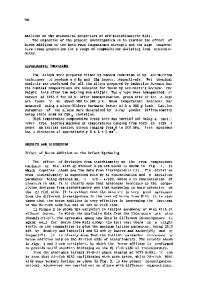Low-Cycle Fatigue Behavior of Polycrystalline NiAl at room Temperature
- PDF / 1,625,178 Bytes
- 6 Pages / 420.48 x 639 pts Page_size
- 54 Downloads / 381 Views
LOW-CYCLE FATIGUE BEHAVIOR OF POLYCRYSTALLINE NiAJ AT ROOM TEMPERATURE KEITH M. EDWARDS and R. GIBALA Department of Materials Science and Engineering The University of Michigan, Ann Arbor, MI 48109 ABSTRACT The room temperature cyclic deformation of a*cast and extruded NiA1 alloy has been investigated. Low-cycle fatigue tests were performed under plastic strain control at strain ranges from 0.0002 to 0.0016. Cyclic hardening behavior has been analyzed and compared to the monotonic tensile and compressive behavior of the same material. Electroless nickel films applied to NiA1 samples have little effect on monotonic deformation behavior, but do have a significant effect on cyclic deformation behavior, particularly cyclic stress asymmetry. Fractographic analysis has suggested that cycling at low plastic strain ranges may promote stable microcracking, while step testing indicates that cycling at lower plastic strain ranges can improve the cyclic life and/or stress levels achieved at the higher plastic strain ranges. Low plastic strain range cyclic prestrain can also significantly increase the monotonic tensile yield and ultimate strength of the material while most of the tensile ductility is retained. INTRODUCTION Nickel aluminide (1-NiA1) with the B2 (CsCl) crystal structure is an intermetallic compound which is currently a candidate for high temperature structural applications. Unfortunately, its lack of ductility and toughness at ambient temperatures and its lack of sufficient strength and creep resistance at elevated temperatures has thus far limited it to primarily non-structural applications. However, NiAl does possess many properties which would make it superior to currently used materials if its low-temperature ductility and hightemperature strength could be improved. Additionally, as a candidate for structural applications, an understanding of the fatigue behavior of this material at ambient, as well as elevated temperatures, is necessary. The purpose of this study is to characterize the room temperature cyclic deformation behavior of polycrystalline NiA1 and relate this to monotonic deformation behavior. As a part of the characterization, the effect of thin nickel surface films on deformation behavior has also been investigated. Surface films have been shown to enhance the room temperature ductility of several bcc metals by inducing mobile dislocation generation at the film/substrate interface [1]. EXPERIMENTAL Three identical NiAl castings 150 mm long and 15 mm in diameter were canned in 72 mm diameter mild steel billets and extruded at 1150°C at a 6:1 reduction in area. The pre-extrusion composition analysis showed that the material was stoichiometric within the 0.5 wt.% accuracy of measurement and contained low levels of oxygen (0.0347 wt.%). Metallographic examination revealed that the NiAl was essentially equiaxed and had an average grain size of approximately 100 ý±m. A texture analysis indicated a texture of 2 to 3 times random along the extrusion axis. Fatigue/tension specimens and Mat. Res. Soc. Symp
Data Loading...











